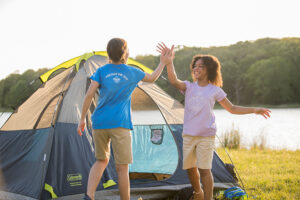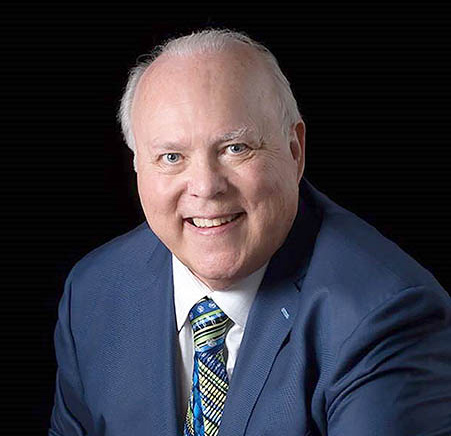Trail to adventure Blog
Trail to adventure Blog
Latest Edition
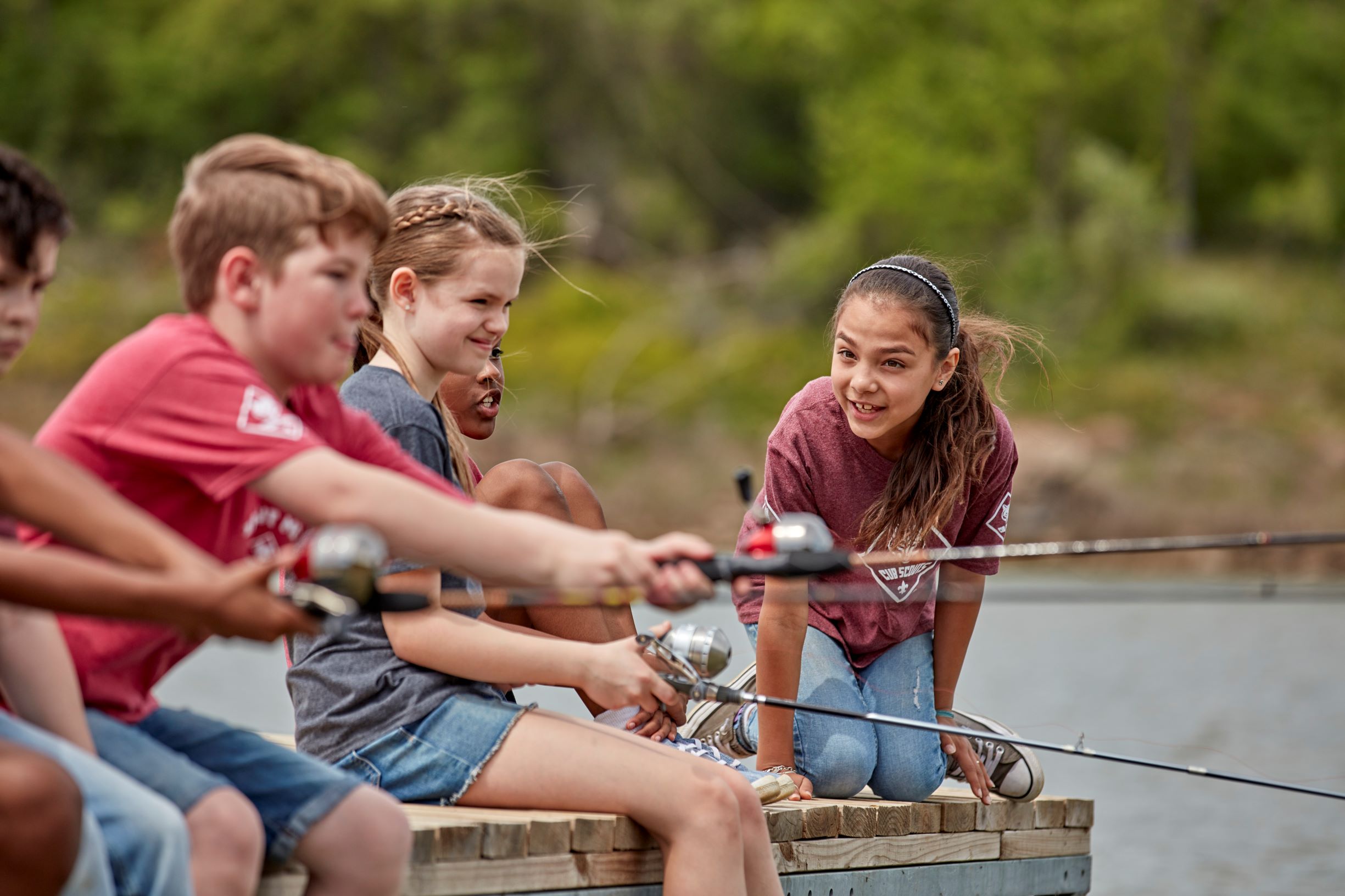
Fishing
Great news for Cub Scouts, as of June 1, 2024, there is a fishing adventure in every Cub Scout rank! Lion Scouts up to Arrow of Light Scouts can earn fishing elective adventures as they progressively learn how to become an accomplished angler. Fishing holds a special place in Scouting history, being one of the original merit badges, and recent surveys have consistently ranked it as one of the top outdoor activities. It’s no wonder that fishing serves as a fantastic recruiting tool for new Scouts and families alike. Fishing also retains Cub Scouts in the program because it is fun, builds useful skills and challenges them on so many levels. Moreover, fishing isn’t just a temporary activity; it’s a lifelong pursuit that Cub Scouts and their families can continue to enjoy together. Furthermore, fishing has the power to reignite the passion of those who may have drifted away from Scouting, as it fosters a sense of community within packs, where knowledge and skills are shared and passed down through generations, much like cherished traditions.
How does it work?
Each rank has specific requirements for fishing elective adventures. In addition, there are den leader resources on for each rank that will outline the basic requirements for earning the fishing elective adventures available on Scouting.org that will launch on June 1, 2024. These requirements emphasize fishing safety and basic fishing knowledge such as fish identification, fishing equipment, biology, casting skills and knots. The adventure always has a fun trip to go fishing with their pack and adult leaders.
How do Cub Scout leaders make it successful?
Fortunately, the BSA Certified Angler Instructor Working Group has been preparing for this for several years. They have created an extensive network of more than 2,000 Certified Angling Instructors (CAI) and Angling Educators (AE) to assist councils with their fishing programs. CAIs and AEs can teach fishing basics to parents and Cub Scout leaders and help them create successful fishing outings and provide fun programs. Leaders are encouraged to contact their local council fishing committee, sign up for an Angling Educator Class, or visit BSA Fishing for more information about Scouting’s Cub Scout fishing resources.
Fishing is more than fun!
The bottom-line is that fishing is a family-friendly, safe, and fun hands-on activity that is an excellent addition to Cub Scout pack programming. It is inexpensive to start a fishing program and teaches Scouts hand-eye coordination, cooperation, team skills, goal setting, environmental awareness, patience, outdoor survival, persistence, problem solving, friendly competition and at the end of the day … storytelling. Help a Scout tell a great fish tale by taking them on a fishing adventure!

Properties
After months and months of juggling maintenance projects, capital improvements and year-round camp visitors, summer camp is just days or weeks away! For our camp rangers and maintenance teams, maintaining camp during the summer camp season can be complex! With new and returning camp staff, hundreds of weekly visitors, and the inevitable breakdown of some piece of equipment, it can be stressful to keep camp “day 1” ready every day.
Here are a few suggestions of how you can leverage your summer camp staff to help them help you!
- Provide resources. Working alongside the camp director, ensure that camp staff understand what a clean, safe and hazard free environment looks like in their specific area and then provide camp staff with cleaning supplies and basic supplies to help you help them keep their respective areas clean and hazard free.
- Regular Inspections. Camp staff can conduct routine inspections of camp facilities, equipment, and grounds. See something? Say Something! They should report any issues, such as damaged buildings, broken equipment, or hazardous conditions, to the maintenance team promptly. This proactive approach can help prevent minor issues from becoming major problems. Make regular inspections a part of their daily camp routine in their assigned areas.
- Have a specific process to notify you when something needs maintenance and communicate it to camp staff. Is this via paper? Via FIIX or other CMMS software? Online? Via text? The easier the process, the more likely you will know when something needs immediate repair. Share a sample of a “work order” that meets your expectations so camp staff know what will best help them help you help them when they submit a work order.
- Promote a Culture of Care: Camp staff can help promote a culture of care and respect for camp facilities among campers and visitors. Encouraging campers to clean up after themselves, use facilities properly, and report any damage they notice can help prevent unnecessary wear and tear on camp facilities. By modeling this behavior as camp staff themselves, campers will also model this behavior.
By actively involving camp staff in camp maintenance efforts, camps can ensure that their facilities remain safe, functional, and enjoyable for all campers and visitors throughout the camp season.
Camping
As we gear up for another exciting summer season of Scouting adventures, I want to take a moment to express my heartfelt gratitude for the incredible work you do as camp leaders. Your dedication and commitment to providing quality programs that enrich the lives of our Scouts do not go unnoticed.
The mission of the Boy Scouts of America comes to life at the camps you serve! Summer camp holds a special place in the heart of every Scout. It is a time of growth, learning, and camaraderie. Each year, Scouts eagerly anticipate the opportunity to attend camp, where they can participate in a variety of activities that challenge them, teach them new skills, and help them forge lifelong friendships. Many of them stay active in Scouting because of the experience they have in your camps!
“Summer camp is a time-honored tradition that provides Scouts with the opportunity to learn new skills, build confidence, and create lasting memories,” says Roger Krone, CEO of the Boy Scouts of America. “I want to extend a sincere thank you to all camp leadership for your tireless efforts in making these experiences possible for our youth.”
With this excitement comes a great responsibility. In Scouting, we will not compromise the safety of our youth, volunteers, and employees. Safety is a value that must be taught and reinforced at every opportunity. We are all responsible and must hold each other accountable to provide a safe environment for all participants. As camp leaders, you play a crucial role in ensuring that our camps are safe, inclusive, and welcoming environments for all Scouts.
I urge you to continue to uphold the highest standards of safety and quality in all aspects of your camp programs. Lean on the NCAP process, your camp staff and council leadership and your support system here at the National Service Center in Outdoor Programs and Properties. We are committed to your success and the success of your camping operation. Don’t forget to take care of yourself too. While my 15 years serving as a camp director were incredibly rewarding, it wasn’t without its long days and challenging moments. It’s crucial to take care of yourself so you can continue to be there for those who rely on you.
I remember my second summer serving as a council program director in the Inland Northwest Council. I was at Camp Grizzly outside Moscow Idaho, where we had a small lake. I tried to get around to all the program areas regularly and one Tuesday afternoon I was at the waterfront. Scouts were working on merit badges and enjoying the cool water. I noticed a group of Scouts near the dock, surrounding another Scout. As I got closer, I realized it was Kody, a Scout with cerebral palsy who was a camper that week. I stood back curious to see what was happening. I then witnessed for the next 40 minutes, Kody’s patrol swimming alongside him as he slowly worked to pass his swimmer test. I saw Scouts cheering him on from the dock and Scout swimming with him stroke for stroke. It was one of the most meaningful moments of my Scouting career so far. Those Scouts exhibited everything Scouting was about that day and 15 years later, I still remember this vivid experience.
I know this summer you will not only provide every Scout with a memorable and rewarding experience, but you will also help instill in them the values of Scouting that will guide them for the rest of their lives.
Thank you once again for your dedication and hard work. We look forward to another successful summer camp season under your leadership.
Yours in Scouting,
Andrea Watson
Director of Outdoor Programs and Properties

National Jamboree
We are thrilled to announce the selection of Michael “Mike” Prachar as a Senior Program Administrative Specialist within the Outdoor Programs and Properties department beginning July 1, 2024. In this role, Mike will serve as the Associate Director of the National Jamboree.
As Associate Director of the National Jamboree, Mike will bring his expertise to support the development, administration, and management of a successful National Jamboree. In addition to his work with the National Jamboree, Mike will work alongside several national outdoor programs and properties subcommittees to support their efforts in delivering safe and impactful outdoor programs to youth across the nation.
Mike began his Scouting career in the Mecklenburg County Council as a district executive, and has since served as a district director, field director, Assistant Scout Executive, and Director of Support Services throughout Scouting including councils in North Carolina, South Carolina, and Maryland. Most recently, Mike has served as the Director of Support Services in the Circle Ten Council in Dallas Texas managing the council’s outdoor programs and properties extensive camping operations.
With Mike’s history of excelling under leadership in various councils and managing various teams, we are confident in his ability to make significant contributions to the success of the National Jamboree and other assigned opportunities within the Outdoor Programs and Properties department. His dedication to empowering volunteers and staff to create dynamic Scouting programs aligns perfectly with our mission and values.
Please join us in extending a warm welcome to Mike Prachar. We look forward to his contributions and collaboration as we continue to serve our Scouting community with excellence.

Biking
May has rolled in and with it – National Bike Month, a time to celebrate the benefits of cycling. This presents a fantastic opportunity to engage Scouts in activities that promote health, environmental consciousness, and community involvement. Here are seven initiatives councils or units may undertake during National Bike Month:
Organize Bike Safety Workshops: Safety should always come first. Packs, troops, and crews can arrange workshops focusing on bike safety, covering topics like helmet usage, proper signaling, and road awareness. Collaborating with local biking organizations or police departments can enhance the credibility and effectiveness of these workshops.
Trail Maintenance Projects: National Bike Month is an excellent occasion to give back to the community. Units can coordinate trail maintenance projects, ensuring that biking trails are safe and enjoyable for all users. This not only fosters a sense of civic duty but also promotes environmental stewardship among Scouts.
Scenic Bike Rides: Explore the beauty of nature while promoting physical activity by organizing scenic bike rides. Whether it’s through local parks or along picturesque trails, these rides can be both recreational and educational, offering Scouts the chance to appreciate the outdoors while learning about conservation efforts in their area.
Cycling Merit Badge Clinics: National Bike Month provides an ideal backdrop for councils to host merit badge clinics focused on cycling. These clinics can cover the requirements for the Cycling merit badge, offering Scouts the opportunity to develop their biking skills under the guidance of experienced instructors.
Bike Safety Demonstrations: Coordinate interactive bike safety demonstrations at local schools or community events. Scouts can showcase proper biking techniques, emphasize the importance of safety gear, and engage participants in hands-on activities that promote safe cycling practices.
Environmental Awareness Campaigns: Use National Bike Month as a platform to raise awareness about environmental issues related to transportation. Councils can organize campaigns highlighting the ecological benefits of cycling, such as reduced carbon emissions and decreased traffic congestion, inspiring Scouts and community members to choose sustainable modes of transportation.
Family Bike Rodeos: Cub Scout packs can host family-friendly bike rodeos featuring skill-building activities and fun challenges for both Scouts and their families. These events can include obstacle courses, slow races, and bike decorating contests, encouraging families to bond over shared outdoor experiences while promoting biking as a healthy and enjoyable activity. The newly updated Cub Scout program launching on June 1, 2024 also includes a cycling related elective adventure for every rank!
National Bike Month offers councils & units a wealth of opportunities to engage Scouts in meaningful activities that promote health, safety, environmental awareness, and community involvement. By embracing initiatives like bike safety workshops, trail maintenance projects, and family bike rodeos, you can empower Scouts to become responsible cyclists and active stewards of their communities. Let’s pedal into National Bike Month with a commitment to promoting the joys of biking for Scouts and communities alike.

Camping
As we announced at the National Outdoor Conference last fall, we have been working to update the Summer Camp Staff Training Guide and we are thrilled to announce this crucial update is now complete!
Staff training is critical to our ability to operate safe, quality camps and this resource is meant to help you in the process. If you’re unsure where to start in crafting your staff training plan, this will provide you with a solid foundation to build upon.
Let’s talk about how you might use it:
- NCAP Standard SQ-402? Check, Check, and Check!: You know that standard about having 28 hours of staff training for a long-term camp staff? The guide has over 20 hours of training material for you to use. There are also a few sample staff week schedules in the appendix to help you in planning the order and how to use the modules.
- New Material: From emergency procedures to staff culture, to effective teaching, the guide will share with you some ways to train your staff to be effective. The guide uses the EDGE method of teaching, and each module follows this plan. Ideally you will model the EDGE teaching method for camp through staff training. New modules about Mental Emotional and Social Health and “Making a Great Staff Member” are just a couple of the new modules we have included. One module even includes an ice cream social at the end!
- Tailor-Made Training Plans: Every camp does things a bit different right? The modules, while placed in the guide in a specific order, have some flexibility for you to move them around to meet your camp needs. Build a training schedule that makes sense for your specific camp’s needs.
- Streamline Your Staff Training Planning: Leverage the guide to plan your first 20 hours of staff training and then add in your own camp specific trainings to meet the needs of your specific camps and the other required training hours. Using the sample staff training schedules include in the guide gives you plenty of time for camp set up as well.
- A BIG THANK YOU: A huge shoutout to the volunteers and professionals who worked to put this guide together for us. Camp directors and program directors from across the country were a part of the planning and execution of the guide. Your hard work hasn’t gone unnoticed, and we’re beyond grateful for everything you’ve done.
We’ve already sent out download links to all our current resident (long-term) camp and program directors. And for those attending National Camping School in 2024, keep an eye out because you’ll have one in the materials you are provided with during your training.
We hope you will use this tool in your planning to train the best camp staff around. Let us know if you have any suggestions for improvements and we will keep working to help you train quality staff for your camp.

Camping
It is almost summer and that can only mean one thing…being in the OUTDOORS!
Saturday, June 8, 2024, is not just any ordinary day—it’s National Get Outdoors Day, and now is the time to gear up to make it an adventure-packed celebration for all our Scouts!
Now, I know you’re always on the lookout for ways to engage and excite your Scouting units and get them out to camp, and what better way to do that than by embracing the great outdoors? On National Get Outdoors Day, let’s make a pact to take our Scouting spirit beyond the usual confines of our meeting location and into the wilderness – or at least somewhere outside.
Here’s the game plan: let’s use this special day to schedule some epic outdoor activities. Think hiking, fishing, archery, you name it. It’s the perfect opportunity to introduce our newly recruited Cub Scouts, and Scouts BSA members to the thrill of outdoor adventures and get them hooked on the magic of Scouting. Maybe even use an event as a kickoff to the new Cub Scout program adventures related to the outdoors. You can choose from several outdoor electives for each rank.
But wait, there’s more! Circle another date on your calendar because June 27 is the “Great American Campout”. It’s a chance for us to come together as a Scouting community and celebrate the joys of camping under the stars. This event is also known as the “Great American Backyard Campout”, so you don’t have to make this a large event. The key is to get our Scouts outside camping and give them a chance to sleep in a tent or even under the stars. Nothing better than camping with the family outdoors or sitting around the campfire telling stories and sharing laughs. Well maybe making S’mores around the campfire could make it better.
And speaking of s’mores, mark August 10, 2024, on your calendar as well. This is one of our favorite “holidays” as it is National S’mores Day! It’s the perfect excuse to indulge in this camping classic and create some sweet memories with your Scouts.
Now, I know what you’re thinking. How do we make all of this happen? Well, it’s simple! Get your team together, brainstorm some exciting outdoor activities, and start spreading the word among your Scouts and their families on how you can celebrate Great Outdoors Month through one of these fun special “holidays”.
So, are you ready to answer the call of the wild and make June 2024, an unforgettable outdoor extravaganza? I sure hope so! Let’s show the world what Scouting is all about—adventure, camaraderie, and the great outdoors!

Aquatics
The Mile Swim BSA award was introduced in 1961 by the BSA Health and Safety Service. The original purpose of the award was for Scouts to learn to swim a mile safely with ease. It was, and remains, a challenging recognition that contributes to fitness and safety. The last time the award requirements were updated was in 1981 when the purpose shifted from a worthwhile accomplishment promoting both safety and physical fitness to “encourage the development of physical fitness by introducing the youth to swimming as regular exercise.” Four hours of required training before swimming the mile was added as a requirement.
Drawing from feedback gathered from BSA Aquatics personnel at camps nationwide, the revised Mile Swim BSA award is refocusing on enhancing swimming stroke effectiveness and efficiency, particularly for individuals seeking improvement. Most Scouts who can walk or bike on level ground for an hour or so without stopping will likely have enough stamina to swim a mile and there are numerous other Scouts BSA programs that promote and develop regular exercise. The Mile Swim BSA award purpose is to build confidence and improve water competency.
UPDATED BSA Mile Swim Award Requirements:
- Successfully complete the BSA swimmer test: Jump feetfirst into water over the head in depth, level off, and begin swimming. Swim 75 yards in a strong manner using one or more of the following strokes: sidestroke, breaststroke, trudgen, or crawl; then swim 25 yards using an easy, resting backstroke. The 100 yards must be completed in one swim without stops and must include at least one sharp turn.
- Learn through discussion and application how skill, stamina, stroke selection, and pace influence distance swimming.
- Pre-qualify for the mile by either swimming continuously for ¼ mile or otherwise demonstrating ability to the satisfaction of a counselor approved by the local council.
- Swim one mile under safe conditions over a course approved by the counselor supervising the swim.
Program Implementation
The revised Mile Swim BSA requirements are effective immediately (Spring/Summer 2024). It is recognized that many BSA camps will already have planned their camp summer aquatics program. Those camps may continue to present the previous (1981) version of the award program; however, all BSA Camps and Mile Swim BSA Counselors should plan on implementing the new Mile Swim BSA requirements for their 2025 programs. The Scouts BSA Mile Swim Emblem (SKU 245) and the Mile Swim Pocket Certificate (SKU 34394) remain unchanged. These recognition items are available at scoutshop.org. Award application and support materials can be found in the 2024 version of BSA Aquatics Supervision No. 34346
The Mile Swim BSA aquatics award is the ultimate recognition of Scouts and Leaders swimming prowess. It is hoped that this revised version of the award will encourage more BSA members to take the plunge and achieve this award.

NCAP
Camp Directors have the chance to showcase the immense effort they and their staff have put into making their camp a source of pride. Each long-term camp undergoes assessment by a national team to evaluate its facilities, program, staffing and compliance with the NCAP standards. For Camp Directors, this presents an opportunity to share your camp’s story!
Running a camp isn’t just something anyone can do! It takes a dedicated team with a shared vision of success to create a memorable program. Use your NCAP assessment as an opportunity to highlight the camp’s strengths and even learn a few ways you might improve. Lead by example, showing staff that it’s not something to fear but rather a chance for the camp to shine.
The assessment team will observe camp operations, so demonstrate how the camp not only meets but exceeds the standards set by the National Camp Accreditation Program. Showcase how you uphold the Boy Scouts of America’s brand with pride, while crafting a program that keeps Scouts eager to return.
Proven Preparation Tactics to Prepare for Your NCAP Assessment:
- Do not wait till the last minute to prepare your final NCAP assessment materials – have the NCAP documentation prepped and implemented before camp begins.
- Review the NCAP circulars that have been released since the last season – have you read NCAP Circular 18 and NCAP Circular 19 yet? This will ensure you understand the changes to standards and new standards/recommended practices.
- Having your camp documents ready – any outstanding items that were not reviewed during the review of your Declaration of Readiness and in subsequent pre-camp meetings with your assessment team leader and team.
- Print a copy of the camp standards at a glance for long-term camp and have it available for review by yourself and the assessment team.
- Be prepared to assist the assessment team around the camp so they can see the programs, staff, and participants. This is a great opportunity to engage additional members of your camp leadership team.
- Invite members of your council’s NCAP committee to help support the assessment team.
- Alert your camp staff that members of the assessment team might ask them questions and discuss their camp areas.
- After the assessment is completed successfully, proudly thank the camp staff and make certain everyone knows you are an NCAP Accredited Camp.
Remember – the NCAP assessment process is designed to HELP you! Don’t miss out on this opportunity to help improve your camp operation and also showcase your incredible camp and staff. Have questions about the NCAP assessment? Email NCAP@Scouting.org.

NCAP
As camp leadership, you know that camp is synonymous with fun, excitement, and life-changing experiences. However, it also comes with its fair share of paperwork. Between meeting the requirements of the National Camp Accreditation Program (NCAP) standards and adhering to local regulations, there is no shortage of paperwork to track and manage.
Some of this paperwork includes the camp first aid logs and incident reports. Understanding how these two items are connected can help you “be prepared” for a successful camp season.
Let’s start by defining these two items:
BSA First Aid Log:
The BSA First Aid Log serves as a detailed record of all medical-related interactions during a specific Scouting activity. This log is normally maintained by the camp health officer or designated individuals with medical expertise. Reminder please use the specific BSA First Aid Log for your camp type (day camp/short-term camp versus long-term camp).
A BSA First Aid log typically includes:
- Date and Time: The precise timing of when the medical intervention occurred.
- Name, Age, Unit: Identification of the individual receiving aid.
- Nature of Injury or Illness: Description of the condition or injury requiring first aid.
- Comments: Description of the activity and location where the injury occurred.
- Treatment/Disposition: Detailed account of the first aid measures administered, including any medications given, wounds treated, or assistance provided.
- Treated by: A record of who treated the individual.
BSA Incident Reporting Tool:
In contrast to the First Aid log, the Incident Reporting focuses on documenting significant incidents or accidents that occur during Scouting activities. For medical related incidents, an incident report is completed whenever the treatment provided exceeds “standard Scout first aid.” For information on how to submit an incident report, click here.
This report is more comprehensive and includes a broader range of incidents beyond medical emergencies, such as environmental hazards, property damage, or conflicts requiring intervention.
The 4 key components of a BSA Incident Reporting Tool typically include:
- General Incident Details: Details of when the incident occurred, where the incident occurred and who reported it.
- Injury/Illness/Damage Information: Details about the claimant, The nature of the injury or damage, cause, and treatment/response.
- Vehicle information: If a vehicle was involved in the incident.
- Witnesses: Contact information for each witness.
So how are they connected?
In cases where a first aid logged injury/treatment is exceeds “standard Scout first aid” an incident report must be filed. Your camp’s BSA First Aid logs are not a replacement for submitting an incident report. Does everything you log in the first aid log require an incident report? Likely not – only if it meets the threshold of beyond “standard Scout first aid”.
You could have several entries in your camp’s first aid logs that do not meet this threshold. For example, a Scout comes in for a band aid. While this would be logged into the First Aid log, it would not rise to the level of also requiring an incident report to be filed.
Speaking of incident reporting, don’t forget that NCAP standard AO-808 was updated for 2024! Within the 2024 AO-808 standard, it states that within 60 days prior to the start of camp, the camp director, program director (for long-term camps and day camps) and professional advisor (for long-term camps, day camps and short-term camps) shall access the BSA Incident Reporting page (www.scouting.org/health-and-safety/incident-report/), download a copy of the current Incident Information Reporting Tool, Youth Protection/ Membership Infraction Information Reporting Tool, and Near Miss Incident Information Reporting Tool and review the balance of the webpage.
The people in the positions stated above must sign a certification statement that this review was completed and keep a copy of each tool available while the camp is in session. The completed certification statement must be provided to your assessment team either with your Declaration of Readiness or presented during the visitation.
In Scouting, we will not compromise the safety of our youth, volunteers, and employees. Safety is a value that must be taught and reinforced at every opportunity. We are all responsible and must hold each other accountable to provide a safe environment for all participants. Documenting incidents and medical interventions is a crucial aspect of ensuring the well-being of Scouts, leaders, and staff members alike.
Past Editions
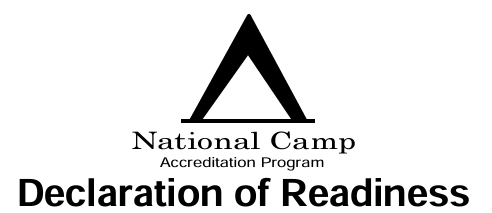
NCAP
The Boy Scouts of America National Camp Accreditation Program (NCAP) Declaration of Readiness (#430-072) is a critical step in ensuring that Scouting camps meet the highest standards of safety and quality. One of the key aspects of completing the Declaration of Readiness successfully is working effectively with your Zone Assessment Team. This article aims to provide guidance on how to collaborate with your team to streamline the process and navigate assessment efficiently.
Understanding the BSA NCAP Declaration of Readiness
The Declaration of Readiness (#430-072) is the Council’s assurance that a camp will be ready to open and prepared to offer a program that meets or exceeds the requirements of the NCAP standards and its Authorization to Operate. The Declaration of Readiness form with its supporting documentation must be submitted to your assigned NCAP Zone Assessment Team Leader no later than May 15 each year for long-term camps. The current version of the Declaration of Readiness (#430-072) can be downloaded from the BSA National Camp Accreditation Program site (scouting.org/ncap). One form is to be submitted for each type of long-term camp you will host (Cub Scout, Scouts BSA etc).
Collaborating with Your Zone Assessment Team
Establish Clear Communication Channels
Communication is key to a successful collaboration with your Zone Assessment Team. Establish clear communication channels early on, ensuring that all relevant stakeholders are) informed about the process and expectations. Regular meetings or conference calls can help keep everyone on the same page and address any questions or concerns that may arise. Share your communication preference and learn theirs – email, phone? Day of the week? Time of Day? Set communication up for success by confirming when and how is the best way to engage.
Assign Responsibilities
Clearly define roles and responsibilities within your camp team and the Zone Assessment Team. Identify who will be responsible for gathering documentation, conducting site inspections, and addressing any deficiencies found during the pre camp inspection. Having designated individuals for each task helps streamline the process and ensures accountability. This is a good way to engage your camp leadership team in the NCAP process, including helping gather the Declaration of Readiness documentation.
Provide Access to Necessary Information
Make sure your Zone Assessment Team has access to all relevant information and documentation needed to complete the assessment by submitting the documents indicated on the Declaration of Readiness form. The Declaration of Readiness form indicates what should be submitted to the Zone Assessment Team. Providing access to this information in advance allows the team to review it thoroughly and identify any areas that may need support prior to the on-site assessment. Discuss with your Zone Assessment Team what format you will be providing your documentation in. Will it be digital? Will it be in paper form? This ensures everyone is prepared to review the material.
Be Open to Feedback
Approach the Declaration of Readiness and Assessment process with an open mind and be receptive to feedback from your Zone Assessment Team. The Zone Assessment Team is dedicated to ensuring the success of your camping operation and wants to ensure you are fully prepared to start camp. Communicate frequently on items that may need additional information or may not be 100% complete.
Working effectively with your Zone Assessment Team is crucial for successfully completing the NCAP Declaration of Readiness and ultimately your NCAP annual assessment. By establishing clear communication channels, assigning responsibilities, providing access to necessary information, being open to feedback, and following up diligently, you can streamline the assessment process and ensure that your camp meets the highest standards of safety and quality.
For more information about the National Camp Accreditation Program, please review the Council Implementation Guide or visit scouting.org/ncap. To contact your Zone Assessment Coordinator, please refer to the last page of the most recent NCAP Circular for a list of e-mail addresses.

NCAP
Hey Camp Leadership!
You know those post-camp and pre-camp inspections we go through every year? Well, they’re not just paperwork. They’re our golden ticket to making sure our camps are top-notch for the Scouts.
Post-camp/Pre-camp Inspection Checklists (430-310) stand as essential tools in ensuring the safety, functionality, and improvement of Scouting facilities (see NCAP Standard FA-701). They serve not only as a checklist for immediate repairs but also as an incredibly useful tool for making capital improvement decisions, laying the groundwork for enhancing the Scouting experience.
Think of it like this: these inspections aren’t just about checking off boxes. They’re like our roadmap for making strategic upgrades and improvements. And guess what? Getting some volunteers involved can turn these inspections into a real game-changer.
Let’s take a look at how we can make the most of these inspections:
Taking Stock: Let’s dive deep into how our camp performed last season. What worked? What needs fixing? From the state of our cabins to our safety protocols, let’s leave no stone unturned. Use the Pre-Camp/Post-Camp inspection form to help guide you through this discussion. The document is meant to help you take a strategic look at the property and the programs at your camp. It will help you plan any maintenance and upgrades or upkeep that camp needs to be ready to open.
Get Lots of People Involved: We’ve got some smart, dedicated people, on our council committees, right? Well, let’s put their heads together. By getting folks from facilities, finance, and program development on board, we can tap into a wealth of knowledge to figure out our next steps. Take them with you to camp and have them walk through the area with you as they will see things that you do not. Invite folks who have never been to camp as well as they will bring a fresh perspective on the walkthrough.
Use the Right Tools: Leverage the BSA Camp Facility Evaluation tool as another tool in this inspection. It’s like our camp-improvement GPS. By using this tool, we’re gathering hard data to steer our decisions. No more flying blind—this tool helps us focus our efforts where they’ll have the biggest impact.
Now, onto the real work:
Spotting Opportunities: Armed with our inspection findings and committee input, it’s time to figure out our action plan. Whether it’s sprucing up our infrastructure or beefing up our safety measures, let’s pinpoint our targets.
Making a Game Plan: Let’s rally some volunteers and map out our strategy. With input from our committees, we’re setting priorities and deadlines. Budgets, timelines, you name it—we’re getting it all sorted. Collaborating with your committees and the council staff helps to build a plan that everyone can agree on and that meets the objectives of the council.
Putting Our Money Where Our Mouth Is: We’re working hand-in-hand with the finance committee to make sure the cash is flowing where it’s needed most. If we need to do a little fundraising to meet the need this team needs to be involved.
Keeping Tabs on Progress: We’ve got our plan locked in—now it’s all about execution. We’re keeping a close eye on things, making tweaks as needed, and celebrating wins along the way. Communicate to your units who are coming as you make these improvements or upgrades to keep the excitement going about the upcoming season.
In a nutshell, by teaming up for post-camp inspections and getting strategic with our planning, we’re setting ourselves up for success. Let’s keep the campfire burning bright!
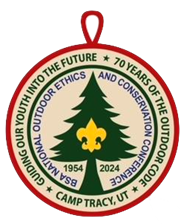
Conservation & Environment
Guiding Our Youth Into the Future 70 Years of the Outdoor Code
Main Conference: September 12-15, 2024
Pre-conference Courses: September 9-12, 2024
Location: Camp Tracy, Salt Lake City, UT
The National Outdoor Ethics and Conservation Conference is the Boy Scouts of America’s largest gathering of volunteers and professionals in the areas of Outdoor Ethics and Conservation. During the two days of the conference you can experience:
- Elective sessions
- Keynote speakers
- Exhibits with great ideas to take back to your council
- Guided discussions with land management professionals
- Representatives on-hand from Leave No Trace and Tread Lightly!
- Contests
- Fellowship with other Scouters who are passionate about conservation
Registration is open now! For more information about this exciting opportunity, please visit the following website: https://www.scouting.org/outdoor-programs/oec-conference/
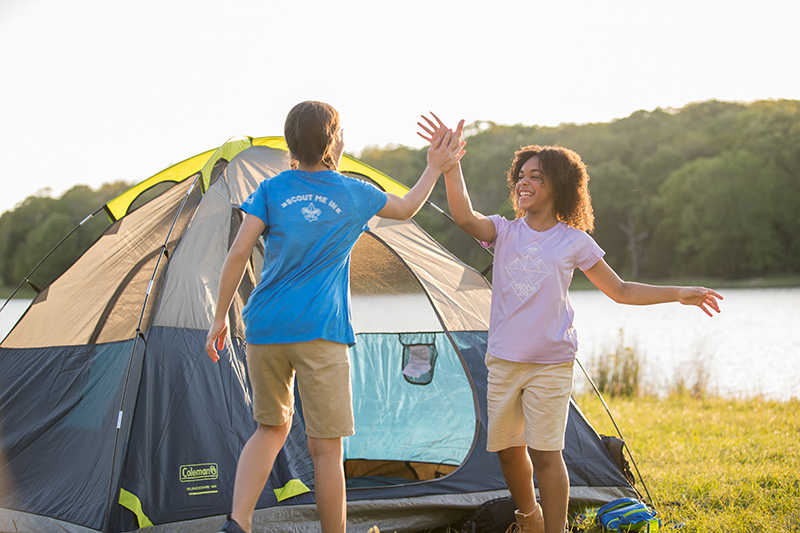
NCAP
Planning a short-term camp within the Boy Scouts of America (BSA) framework requires meticulous attention to safety considerations. The BSA’s National Camp Accreditation Program (NCAP) provides a comprehensive set of guidelines to ensure the well-being of participants. While NCAP offers valuable standards that help create a safer environment, short-term camp administrators and event organizers must still be proactive in addressing safety concerns. This article briefly introduces ten critical aspects of safety planning when organizing a council-sponsored short-term camp under NCAP guidelines (scouting.org/ncap).
Site Assessment:
Before anything else, organizers must conduct a thorough risk assessment of the event location. Using the NCAP Site Appraisal Form is a great start, especially if your short-term camp is not held at a BSA NCAP accredited property. Identifying potential hazards such as uneven terrain, wildlife encounters, or proximity to bodies of water is crucial. Addressing these risks in advance allows for effective mitigation strategies to be put in place. Check out NCAP Standard SA-002 for details on assessing your site location.
Staff Training:
A well-trained staff is the backbone of a safe camp. Organizers must ensure that all staff members are proficient in first aid, emergency response, and BSA safety protocols. Regular training sessions and drills contribute to a quick and effective response in case of emergencies. Ensure you have thoroughly reviewed the training required for each position and the programs you will offer. The Staff Qualification “400” series standards are a critical place to start. Be sure to view the verification section for each standard so you know what training verifications specifically to look for.
Health and Medical Considerations:
Accurate health records of all participants, including dietary restrictions and medical conditions, should be collected during registration. Having qualified medical personnel on-site is required, and an emergency medical plan must be in place, including having a copy of the current medical policies for your council. Touch base with your local council health supervisor to be sure you have the most current copy. Check out the HS “500” series standards, especially HS-503, HS-505 and more. For detailed requirements for your camp health officer for your location, review SQ-405.
Transportation Safety:
If the camp involves transportation, adherence to BSA transportation policies is paramount. This includes driver qualifications, vehicle maintenance, and seatbelt usage. Additionally, organizers should have a contingency plan for unexpected travel-related issues. In 2024 information was included in NCAP standard PS-216 to also include additional youth protection considerations as well.
Campsite Security:
Ensuring the security of the campsite is critical for the well-being of participants. Adequate lighting, secure sleeping arrangements, and surveillance measures should be in place. Event organizers should collaborate with local law enforcement to address any security concerns in the surrounding area. When is the last time your camper security plan was updated for your specific short-term camp location? This would be a great project for your local council enterprise risk management committee. Visit NCAP standard AO-804 for details on camper security.
Aquatics Safety:
If the camp involves water activities, event organizers must strictly adhere to BSA aquatics guidelines. Ensuring proper supervision, life jacket usage, and emergency response plans for water-related incidents are essential components of a safe short-term camp. The 2024 NCAP standards and the Guide to Safe Scouting “Safe Swim Defense and “Safety Afloat” policies will help you plan for aquatics activities at your short-term camp.
Fire Safety:
Camps often involve campfires, cooking, and other fire-related activities. Compliance with BSA fire safety guidelines, including supervision during cooking, and appropriate fire extinguishing equipment, is crucial to prevent accidents. Review NCAP standards FA-703,705,706 as you plan your short-term camp.
Weather Preparedness:
Unpredictable weather conditions pose a significant threat to camp safety. Monitoring weather forecasts, having an emergency shelter plan, and educating staff and participants about weather-related risks are essential components of safety planning. NCAP standard AO-805 helps each of us prepare for all types of emergencies, including weather. These emergencies may vary based on the time of year you are hosting your short-term camp.
Communication Protocols:
Establishing effective communication channels within the camp is vital. Whether through two-way radios, designated meeting points, or other means, clear communication ensures a rapid response to emergencies and facilitates coordination among staff members. NCAP standard AO-807 has details on how you can be prepared to communicate effectively.
Emergency Evacuation Plan:
Every camp must have a well-defined emergency evacuation plan. This plan should account for various scenarios, including natural disasters or medical emergencies. Regular drills should be conducted to familiarize staff and participants with evacuation procedures. A full list of emergencies you must have a plan for are included in NCAP standard AO-805. This list should also be reviewed by your local council enterprise risk management committee to determine if any other plans should be developed for your specific event and location.
Organizing a short-term camp under the standards set forth in the National Camp Accreditation Program requires a comprehensive approach to safety planning. Each short-term camp must have a currently certified Short-term camp administrator as well. By addressing risk factors, prioritizing staff training, and implementing robust safety protocols, event organizers can create an environment where participants can enjoy enriching experiences while minimizing potential hazards. Ultimately, the goal is to uphold the aims of the Boy Scouts of America while emphasizing the safety of all involved in the camping experience. It’s a new year so be sure you use the newest standards – 2024. These standards and other critical resources are available online at www.scouting.org/ncap.
Additional resources:
National Camp Accreditation Program – 2024 Standards
Guide to Safe Scouting
Standards at a Glance (Short-term Camp)
Scouting.org Short-term Camp webpage

Camping
Introducing Cub Scouts and their parents to the thrill of day and overnight camps requires a thoughtful marketing strategy that combines the best practices from the Boy Scouts of America and successful initiatives from local BSA councils. Leveraging social media, website improvements, and print media can create a dynamic and impactful campaign that resonates with families seeking enriching experiences for their young Scouts.
Social Media Engagement:
Harnessing the influence of social media platforms is a cornerstone of modern marketing. Successful local BSA Councils often excel in creating engaging content for Facebook, Instagram, and Twitter. For instance, sharing real-time updates during camp sessions, posting testimonials from enthusiastic Cub Scouts, and hosting live Q&A sessions with camp organizers can generate excitement. Be sure to incorporate visually appealing graphics and use targeted advertising to reach specific age groups and interests within the Cub Scout community. How you promote day camp will look different than marketing an overnight camp.
Website Improvements:
Your website is the entry point to converting interest to a registered camper. Local BSA councils who have the best success have websites with easy navigation, vibrant visuals, and detailed information on activities. The Greater New York Councils BSA, for instance, provides a comprehensive online platform featuring camp highlights, safety measures, and a parent resource section. You could even consider incorporating a blog or news section for regular updates, and ensure the website is optimized for mobile devices for convenient access. Likely the majority of individuals who use your camp website(s) are doing so from their mobile device.
Print Media Campaigns:
Print media remains a helpful tool for reaching parents and Cub Scouts with camping information. Local BSA councils, such as the Greater St. Louis Area Council, effectively utilize newsletters and newspapers to share success stories and camp highlights. Brochures and flyers distributed in schools and community centers serve as tangible reminders. Don’t forget to align with BSA guidelines for design and content. You could also consider collaborating with local businesses to sponsor and distribute promotional materials. This collaboration can help take financial pressure of your camp budgets.
Testimonials and Success Stories:
One of the most persuasive marketing tools is the authentic voice of satisfied parents and Cub Scouts. Think of how you decide to buy a product. You likely read reviews from others. Consider the use of testimonials in various marketing materials. The Northern Star Scouting Council in Minnesota, for instance, features video testimonials on their website, showcasing the impact of camp experiences. Encourage parents and Cub Scouts to share their stories through written testimonials, photos, and videos to build trust and credibility.
Highlight Educational and Developmental Benefits:
Share the outcomes of camp! Camp delivers the educational and developmental benefits of Scouting programs. Each of us should work to effectively incorporate these messages into camp marketing. The Michigan Crossroads Council, for instance, highlights skill-building activities, leadership development, and character-building experiences in their camp promotions. Align the camp’s offerings with the BSA’s educational goals and values, emphasizing the holistic development of young Scouts. Parents have many choices of where to send their kids to camps of all types. This focus on why Cub Scout day or overnight camp is so important can resonate with a parent who is looking for a camping program that helps build resilience and skills in their child.
In conclusion, marketing day and overnight camps to Cub Scouts and their parents requires a comprehensive strategy that blends social media engagement, website improvements, and print media campaigns. By leveraging successful examples from local BSA councils and adhering to BSA guidelines, camp leadership can craft a compelling marketing plan that showcases the transformative and adventure-filled experiences awaiting Cub Scouts in the world of Cub Scout camp.

NCAP
In just a few months, the warm breeze will herald the arrival of summer. Families and adult leaders will be eagerly preparing their Scouts for the quintessential experience of summer camp. A critical component of a successful camp adventure lies in the creation of a well-balanced and nutritionally sound menu. Drawing on the expertise of Penn State in the realm of nutrition, Scout camps can develop a menu that not only caters to the unique needs of campers but also ensures they receive the essential nutrients for a summer camp week full of fun and activities.
For the last few years, the BSA has partnered with Penn State to support our camp menu and nutrition planning. Penn State advocates for a diverse array of food groups to form the foundation of a robust camp menu. Breakfasts can be fortified with whole-grain cereals, yogurt, and a selection of fresh fruits to kickstart the day with complex carbohydrates, protein, and vital vitamins. For lunch, incorporating colorful salads with lean protein sources such as grilled chicken or chickpeas ensures a nutrient-rich midday meal. Dinner options may include whole-grain pasta with a variety of vegetables and a lean protein source, offering sustained energy for the evening’s campfires or other activities.
Beyond the inclusion of diverse food groups, Penn State emphasizes the importance of portion control to meet the nutritional needs of campers without overindulgence. By offering a variety of options in appropriate serving sizes, campers can enjoy a range of flavors while maintaining a balanced diet. Snack choices can include a mix of nuts, seeds, and dried fruits, providing energy-dense and easily transportable options for between-meal cravings.
Ensuring food safety in camp settings is paramount, and Penn State provides valuable insights into proper food handling techniques. From safe storage practices for perishables to maintaining appropriate cooking temperatures, these guidelines help prevent foodborne illnesses in the camp environment. Additionally, incorporating non-perishable and easy-to-store items into the menu streamlines meal preparation without compromising nutritional value. Don’t forget to be prepared for special dietary needs. The big 8 recently became the big 9 (welcome sesame!) for major allergens. Double check your camp’s process for managing and supporting special dietary needs for your Scouts and Scouters. This a key aspect of customer service but also for the health and wellbeing of our campers.
Hydration takes center stage in Penn State’s approach to summer camp nutrition. With increased outdoor activities and potential exposure to higher temperatures, staying well-hydrated becomes crucial. Camp menus can feature hydrating options such as fruit-infused water, electrolyte-rich beverages, and watermelon slices to keep campers refreshed throughout their summer escapades.
In line with responsible camping practices, Penn State encourages eco-friendly choices in menu planning. Opting for reusable containers, minimizing single-use plastics, and emphasizing sustainable sourcing contribute to an environmentally conscious camping experience.
In conclusion, crafting a nutritious summer overnight camp menu inspired by Penn State’s recommendations ensures that campers not only enjoy their culinary experiences but also receive the essential nutrients needed for an active and memorable summer. By incorporating a variety of food groups, practicing food safety, promoting hydration, and adopting eco-friendly practices, camp organizers and families can contribute to the overall well-being and enjoyment of the camp experience. Visit the Penn State website to review the extensive collection of Penn State resources.
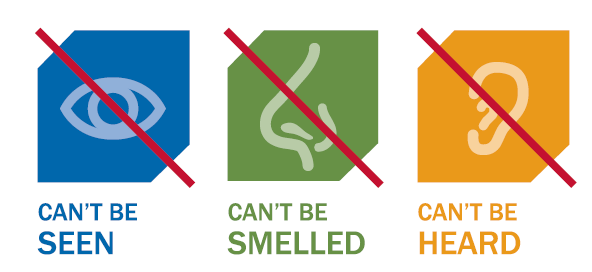
Camping
According to the Consumer Product Safety Commission, people die every year from carbon monoxide poisoning from the use of portable camping heaters, lanterns, or stoves inside tents, campers, and vehicles. Scouters often use many devices that can produce carbon monoxide. This includes trying to stay warm and overlooking the danger of bringing heating devices into enclosures or tents. As such, it’s essential to know about this hazard and what steps to take to prevent carbon monoxide poisoning in outdoor settings.
What is Carbon Monoxide?
Carbon Monoxide (CO) is a non-irritant, colorless, and odorless gas produced by the incomplete combustion of carbon-based fuels. In Scouting, CO is often found in the fumes of portable camping heaters, lanterns, or stoves. Your Scout camp facility likely has additional sources too.
Why is CO such a risk?
When breathed in, CO will bind to your blood’s hemoglobin with an affinity 200-250 times greater than that of oxygen. This means your blood cannot deliver the oxygen needed by your organs and tissues. Like choking, you deprive your body of the necessary oxygen you need to survive.
What are the symptoms of CO Poisoning?
Symptoms resemble the flu and include headache, dizziness, weakness, upset stomach, vomiting, chest pains, and confusion. People sleeping can die from breathing in large amounts of CO before they even have symptoms.
How can I prevent CO poisoning?
Fuel-burning equipment such as camping stoves, camping heaters, lanterns, and charcoal grills should never be used inside a tent, cabin, or other enclosed shelter. During winter camping, be particularly careful if you create enclosed structures, such as wrapping outdoor pavilions or pop-up tents with plastic. Opening tent windows/doors or having small openings in enclosed areas is insufficient to prevent the build-up of CO concentrations from these devices.
What to do if you experience symptoms of CO poisoning?
Get outside to fresh air immediately! Also, contact a doctor immediately for a proper diagnosis.
No Flames in Tents
The Boy Scouts of America and other camping organizations have long adopted a policy of “No Flames in Tents.” Other than the apparent fire danger this action prevents, most don’t think of the CO poisoning risk it eliminates. Since CO poisoning provides no visual, sellable, or auditory clues, the “No Flame in Tents” policy can easily be extrapolated to no propane-powered heaters in tents or enclosures.
Camping
This will be a continuing series of articles on various aspects of the properties we own, lease, care for, and look to make better. As we all know, the program of Scouting is valuable to the growth of youth in this country and around the world. Where we deliver that program needs to convey that value and the coming articles are intended to assist us all in making that conveyance to our current users, as well as all our future users and their families.
In the last edition of Let’s Do Better, we discussed forests and the trees that make up those wonderful places folks in this organization like to spend quality time in! And while we talked about replanting and harvesting the various species that grow within those forests we didn’t talk very much about protecting them. Sure, we could talk about cutting break lines in case of fire. Installing roads through the forests so there’s access should fire occur (these can be minimal and combined with a break line is ideal). Maintaining a forest stand is a whole lot more than just cutting out the dead wood! But, how else can we protect this precious asset? Property Insurance.
Little thought was given to how complex and involved the topic of insurance was going to be. Like many, we know it’s a good idea to ‘carry’ insurance. Yes, we do pay for it. Why? No, not why do we pay for it. Why do we ‘carry’ it? Why do we pursue having insurance in the first place?
“Insurance is a means of protection from financial loss.”
That’s a line from the Wikipedia article on insurance much of this month’s article is based upon. A means of protection from financial loss.
The idea of insurance if you will, is quite old. In fact, similar “transferring or distributing risk” was practiced in the 3rd and 2nd millennia BC. Traders in that day spread their goods across several transport vehicles with the expectation that one or more of the transports would not make the journey. The vehicles at the time were vessels on the rivers and streams by which traders moved their goods to a market. A few factors could possibly overturn a vessel and the cargo was lost. In this way, the trader insured at least some of his goods made it to market, if not all.
“The law of general average constitutes the fundamental principle that underlies all insurance.”
Tablets from the dynasty of Nerva-Antonine in the ruins of the Temple of Antinous in Aegyptus (Egypt) in approximately 133 AD during the reign of Hadrian of the Roman Empire prescribed rules and membership dues of a burial society. In essence, early burial insurance. Other concepts of insurance have been found in 3rd century BC Hindu scriptures. In ancient Greece they developed marine loans in order to ensure their cargo was delivered in order to receive payment in full. The idea of a separate contract to insure something was invented in the 14th century in Genoa. Life insurance to cover a person was not created until 1583, in London. Property insurance can be traced to the Great Fire of London in 1666 which consumed more than 13,000 homes. In fact, in the 1680s the first fire insurance company was established at the back of the Royal Exchange, the very place the first life insurance policy was written. As London grew as a center for trade the demand for marine insurance increased. Edward Lloyd saw the opportunity, opened a “coffee house” whereby shippers would meet with folks who were willing to underwrite a shipment thus creating Lloyd’s of London as an insurance market.
So, even though insurance has been around for centuries, most of the varying types of insurance we know today have really been developed since the late 18th century. Even today new types of policies are created in response to world events.
But the question remains, why? Insurance is basically a pooling of funds from many, to pay for losses incurred by a few. Most of us have car insurance. We pay monthly premiums, the pool, and file a claim when we encounter an accident. If the claim meets the terms of the policy, we’re paying premiums on, the insurance company pulls from that pool of funds we’ve been contributing to along with many other drivers and pays us, or the company repairing the damage, what’s required to fix, or “make whole again” what we possess. Then we can drive our newly repaired vehicle down the road again. Easy enough, right? The line, “If the claim meets…” is loaded with a lot of subjects to be dissected a bit to better understand the purpose of this month’s article for Let’s Do Better when looking at our property insurance!
You all know that numerous insurance companies exist. We do have a choice when it comes to the purchase of insurance in whatever form we’re looking to acquire. And to say there’s a choice is a big understatement! Insurance companies exist because they make money. In 2020, insurance companies in the US of A had $2.5 trillion in direct premiums written. Yes, that’s trillion with a ’T’! That’s a bunch of billions, and a whole lot more millions. You all also know that when you file a claim the expectation is one of apprehension as to the effort it’s going to take to get something out of the insurance company to help you pay for your loss. But yet, they have trillions!
Also remember you entered into this contract, the policy, with the insurance company. You pay premiums for the coverage which should be stipulated in that contract. The insurance company when you file a claim has to examine the terms of your contract with them, see that it meets the terms of paying you for your loss, and then distributing funds. This all takes time as you are not the only person insured. As all of the contracts, policies, are not the same clarifying the loss and how it meets the terms of it may be more involved than a simple “I was in an accident. I need to repair my car. Please pay me so I can repair my car and get on with my life” scenario. Why is that?
Again, you are one of many paying into a pool of funds by which claims are drawn from.
Given some of the catastrophic events that have occurred, the insurance companies cannot just pay every claim as each needs to be vetted and shown to be accurate and true. Some insurance companies have gone out of business as they exceeded the funds to pay claims on. Not a good scenario for you in that one! So, again, why mention this?
You need to pay attention to several items when purchasing property insurance. Plain and simple.
Are you purchasing the correct type of insurance contract (policy) for what it is your
insuring? What’s the value of the item your insuring? The value today and if it’s an item that appreciates, the value in the coming years. This is what you are protecting! This is the potential loss item. What are the parameters that you and the insurance company agree to for your potential loss? This would be the terms under which the insurance company will reimburse you for the loss of the item insured.
And that is where a lot of folks get confused and where the unhappy circumstances of trying to get that reimbursement come from. You simply don’t understand the terms you agreed to! And you wouldn’t be alone in that! More than likely, you wanted a low premium. But, from the insurance company side you’re contributing to the pool a little, but when you make a claim, the expectation is the company will pay you fully for your loss. From their side you haven’t contributed enough to the pool to be compensated that way and if you looked at your contract that’s probably what it says. That’s where all the data the companies collect nowadays is crunched over and over again so they know practically to the penny what an accident like you’ve experienced should cost them. That’s how they figured your contract to protect the item you’re insuring and the terms of that protection.
So, next time you’re in the market for insurance, what are you going to look at? What questions will you ask and how closely are you going to examine the contract/policy? Yes, you want protection, but you want it fairly and to where it will adequately cover your loss.
Several councils in the organization have experienced devastating fires on their properties in recent years. They’ve lost buildings. They’ve lost the forests which grew on the property. They’ve lost the business side of the operation which has affected their financial position. Hopefully, we’ve all learned that some were better insured than others and have made appropriate adjustments to what our property insurance contracts cover. Pay attention to the terms of those contracts and what can be expected in the “to make whole again” process. Are you paying for simple coverage, or are you paying for replacement cost coverage? With the cost of materials and labor rising the way they are today, pay that extra so you can get your property back up and running more completely! Be sure to obtain the contract that best protects you and what your insuring. Insurance is not necessarily all that complex, but in many ways it helps all of us manage our property assets so we are minimally exposed to a substantial loss. And that protects us all!
See you next issue!
Dave Cornell
Architect
Mar ’22
The Outdoor Programs / Properties Team is ready to assist and guide in any respect to making the program of Scouting the best youth program! Reach out to any member of the team and we’ll endeavor to provide quality answers to any issue you may have and/or facing. We look forward to working together to make the program the best ever!

Camping
If there is one thing with which every Scout I talk to these days can agree, it is this—just how much we are all looking forward to getting back to camp this summer. After two years of spending too much time indoors and away from friends, the 2022 camping season calls to us with promises of adventure, fun, personal growth, and friends—both old and new.
With so many Scouts counting down the days to their summer camp adventure, I want to encourage each of us to ask, “Is your favorite camp ready to provide a mountaintop experience to the girls and women who will attend?”
Consider this: We go to the places we are invited, but we return to the places where we feel welcome. In too many instances, we have invited the girls and women in our community to join us in Scouting programs, but we haven’t done all the necessary work to make them feel welcome — to ensure that they will want to keep coming back.
Jack Welch, former CEO of General Electric, said, “Deal with the world as it is, not how you’d like it to be.” How does this relate to summer camp? It begins with getting truthful about what the readiness level of your camp REALLY is. We don’t solve anything by simply saying, “let’s just build single-gender bathrooms.” We must take a hard and honest look at where we are, or aren’t, regarding our camp structure, and consider where we need to be. Yes, I do understand cost is a factor but there are still ways to make improvements.
Start by pausing and asking what is working well and what is not? How can your camp work to make things better, to be more inclusive and welcoming to all who come and spend time on your properties and in your campsites?
So, let’s get practical and tactical! Here are my 12 tips to make 2022 the best camp experience that our Scouts have ever had.
Awesome Camp Tip #1: Words Matter. Let’s not differentiate between boys and girls; instead let’s just call them Scouts.
Awesome Camp Tip #2: Sell feminine hygiene products in your trading post.
Awesome Camp Tip #3: Put trash cans with liners in every bathroom stall. This is both welcoming and sanitary.
Awesome Camp Tip #4: Mark the gender of every bathroom, including gender-neutral facilities.
Although we could call these first four tips the “small things matter” section; in fact, they matter a lot. Why? Because attending to the small things makes the girls and the women in your camp feel welcome. If a female can’t properly dispose of a feminine product, or purchase one if she is in need, I can tell you from personal experience, she is not going to feel welcome.
Awesome Camp Tip # 5: Avoid terms such as “Smother mother” and “helicopter mom. At your camp, are adult females encouraged to attend along with their youth, or “to cut the umbilical cord?” When you hear these terms being used by staff, by Scouts, or by adult leaders, take a moment and explain why speaking about women in camp this way perpetuates a stereotype that says women complicate the camp environment, rather than contribute to it.
Awesome Camp Tip # 5: Re-evaluate your application process for staff.
Are leadership experiences that youth gain outside of Scouting valued, or do you base your assessment purely on Scout experience? There is a long list of experiences that prepare a young person to be a great camp staffer. Quality camp programs have a lot to do with a focus on customer service, and youth get that experience in various ways.
Awesome Camp Tip # 6: Take the feedback forms you get each week seriously.
We’ve all read a feedback form that is overly harsh and unfair. Those are easy to disregard, but does your camp have a practice of looking honestly at the feedback you receive, or are you rationalizing why you can disregard what you’re reading? Are you willing to pivot and adjust throughout your camp season to ensure that one person’s challenging experience this week does not become someone else’s challenging experience next week?
Awesome Camp Tip #7: Set behavior expectations prior to arrival for all units.
Share behavior expectations with unit leaders as part of pre-camp orientation information. Emphasize the expectations in staff training and review with campers during orientation each week. Provide a reporting example and make it clear that reporting of unacceptable behavior is mandatory. Everyone in camp is responsible for ensuring a healthy and welcoming environment for all campers! It is NOT our job to decide whether a situation merits being reported; it is our job to report issues and allow camp leadership to assess the situation and decide what action to take.
Awesome Camp Tip #8: Make sure all units know what to expect each day of camp, prior to arriving. Don’t assume legacy knowledge from any unit or leader. Offer a pre-camp Q&A session.
Awesome Camp Tip #9: Swimwear — stop using the word MODEST.
From the National BSA Aquatics Subcommittee; “We recommend that swimwear should be comfortable, functional, and appropriate for the specific aquatic activity. As always, we remind everyone that Scouting’s Barriers to Abuse state, ‘Appropriate attire is required for all activities’. Policies should reflect the BSA’s statement and commitment to diversity, equity, and inclusion.”
Awesome Camp Tip #10: Establish an Upstander culture in your camp.
Create a see-something, say-something expectation among staff, campers, and adult leaders. Make public statements to of expectations. Ensure it’s clear to everyone in camp that certain behaviors are not appropriate and will be addressed quickly if they occur.
I ran a camp for youth and adults with disabilities for 10 years. Trust me when I tell you that everyone knows when something has “happened” in camp. Often the details are not appropriate to share with everyone, but your transparency in sharing that there’s been an incident and it is being handled, and then using this as a teachable moment to remind everyone about rules and expectations, is an example of your leadership!
Awesome Camp Tip #11: Stop making exceptions or excuses for bad behavior by anyone in camp, especially when it is displayed by adults.
The notion that we don’t want to make Scouter X upset because he or she has given 25 years or even 50 to Scouting is not acceptable. . We need to treat everyone equitably.
Awesome Camp Tip #12: It takes all of us working together to impact change. Find and focus on your allies and let them help influence others
Find the people at your camp, and in your council, who want to make Scouting an equal and fair space for all youth to thrive. Align yourselves with them. Ask for their help. Get to know the other women in your council. Introduce yourself to other women in camp. Work together. Find the leaders already in place in your Scouting community who want to help you and let them! Often those leaders already in place are men. They may be men who are equally passionate about our camps being a safe and welcoming place for girls and women to enjoy Scouting. Look for them. They can teach you a lot, and you can teach them too!
I’ll leave you with this vision for the future of Scouting:
Let’s make sure every Scout camp in our country embraces the opportunity to provide a welcoming place for all girls and women, so that they can contribute to a thriving Scouting movement. All of us can help improve Scouting for each young person. Please share with us via outdoorprograms@scouting.org ways that you helped provide an even more welcoming environment for your campers.
Now let’s go camping, see you on the Scouting Trail!

Aquatics
As Scouts we strive to remain active outdoors year round and for many of us that means be out in cool to very cold air and potentially cold water temperatures. Whether you are hiking along a creek or lake or paddling on the water if accidently fall in cold water your chances for survival are good if you understand how your body responses to cold water and how you can best support yourself until help arrives.
Dr. Gordon Giesbrecht of the University of Manitoba has performed extensive research on cold water exposure and has the following recommendations.
First, let’s consider water temperatures. Water temperatures for swimming can be simply classified as “Pleasant” (68F – 77F); “Ok, once used to it” (59F – 68F); “Brisk, nippy” (50F-59F); “Darn cold” (41F – 50F); and “FREEZING” (32F – 41F, remember). In “Pleasant” conditions it is fun and easy to with swim without any additional cold protection (like a wet suit). With “Ok” conditions you will feel a bit cool at first but get used to it. When the water is “Brisk” it will feel very cool when you first get in but with experience you can swim for a while before hypothermia is a serious risk. At “Darn cold” water temperature it is painful to get in and only short swims of a few minutes can be tolerated before significant risks occur. And, as you might expect, at “Freezing” it is extremely painful to be in the water and the time in the water should be limited to only a minute or two. Also, remember, in general, water temperatures do not change as quickly as air temperature during the course of the day and once water gets cold, say due to cold nights, the water is unlikely to warm up much in the day. So, it could be that if you fall into water during cold seasons, it is possible for the water to be cooler than the air temperature during the day. Another thing to keep in mind is that fresh water freezes at 32F and salt water at a colder temperature. So, although salt water may not be frozen the water temperature could actually colder than “freezing” (32F).
Dr. Gordon Giesbrecht of the University of Manitoba has performed extensive research on cold water exposure in humans and has the following recommendation for what to do if you find yourself in cold water.
The 1 Minute; 10 Minute; 1 Hour Principle.
So, let’s explore more about what happens when you accidently immerse yourself in cold water. First, the good news, you can survive a fairly long time in cold water if you DON’T PANIC, stay calm and follow these steps to help yourself.
Cold Shock Response. In cold water the immediate response of your body is to uncontrollably gasp for air and hyperventilate (think about the time when your big brother doused you with a bucket of ice water). So, first, DON’T PANIC and keep your head above the water. This this is critical because you can easily inhale (aspirate) water into your lungs which is extremely dangerous. Keep reminding yourself to stay calm, keep your head above water and control your breathing. Adjust your breathing so that it is steady and evenly paced. Once you have steadied your breathing and you have relaxed as best you can you can then consider what actions to take next.
After 1 minute in very cold water Cold Incapacitation begins to impact your body functions. This is due to the effect of cold water on your nerves and muscles. It becomes painful to move your muscles and your ability to control your muscles becomes increasing worse. This hampers your body’s ability to move or hold on to things. Over the next 10 to 20 minutes under these conditions the symptoms will continue to a point where the use of your limbs is basically useless. Therefore, you must quickly plan on what to do and then carry out your plan prior to complete loss of useful muscle function. The primary goal now is to quickly (within 10 minutes or so) get as much of your body out of the water as possible. If you were in a boat, Don’t Panic, control your breathing and get to the boat and try to get in or crawl on top of an overturned boat. If you fell into a lake or river from the bank or a bridge, the same applies, Don’t Panic, control your breathing and find something to climb on or find a spot to get out of water within 10 minutes.
The longer you are in the water the greater risk of developing hypothermia. If you cannot self-rescue by getting your body out of the water you then must begin to prepare for the possibility of hypothermia. Hypothermia, is the decrease of your body’s core temperature. Many factors contribute to hypothermia and how fast it can happen. This includes the water temperature, how much of the body in immersed in the water and your own body’s size and condition. In cold water (water below 68F), most people will become hypothermic in 1 – 2 hours. So, if you haven’t been able to get yourself out of the water you need to think back to your Scout aquatics training (Swimming merit badge) to the H.E.L.P. position in cold water (Heat, Escape, Lessening, Position). That can make a big difference in slowing down the onset of hypothermia. This can only be effectively done if you have your lifejacket on so that’s another great reason to always wear your lifejacket when in a boat! If you are with one or more buddies the best thing to do is to get into a HUDDLE position where you crowd together to conserve body heat. This action also slows the onset of hypothermia.
Once you become hypothermic you will eventually lose consciousness. At that point you have around another hour or so until you may experience cardiac arrest. In all cases, when out on a hike or on the water you should always be certain your leaders must know where you are and when you are expected back. If you are late returning, they should begin to search for you to provide help.
So, remember, if you find yourself accidently immersed in cold water remember the 1 minute, 10 minute and 1 hour principle and: 1) Don’t Panic; 2) Keep you head above the water and try to control your breathing; 3) Make a plan for getting as much of your body as of the water as quickly as possible; 4) If you cannot get out of the water within 10 or so minutes assume the HELP position or if with buddies, then Huddle-UP to delay the onset of hypothermia. Always wear your lifejacket when in a boat and also always be sure your leaders know your plans when going on a hike or boating so if you are late returning, they can find you and give your help.

Properties
If your camp location experiences heavy snowfalls during the winter months, your roofs may be at risk of collapsing. It’s not just the amount of snow, but also the snow’s water content that contributes to the overall weight. One inch of water weighs 5.2 pounds per square foot, and snow can have different distributions of water content. A particularly wet snowfall can pose a greater danger for your roof, and rain falling on the snow can triple its weight.
The following tips from Church Mutual can help you prevent roof collapse from snow:
- Regularly inspect your roofs for damage. Well-maintained roofs are less susceptible to snow collapse. Perform an annual inspection on every roof at your camp — or hire a contractor to do so. Remember to follow all safety regulations.
- Watch for warning signs that may indicate structural weakness in your roofs. Warning signs to keep an eye out for include:
-
- Doors or windows that are difficult to open.
- Cracking, popping or groaning sounds.
- Bent or deformed metal roof supports or beams.
- Walls that have cracks or are bending outward.
- Roofline or decking that is sagging or wavy.
- Determine the maximum safe snow depth for each roof. This should be based on each roof’s load capacity as determined by an engineer during the planning and construction process. If you don’t know the load capacity of your camp’s roofs, consider enlisting the services of an engineer to provide you with this crucial information. It’s also important to know the type and amount of snow your camp location typically receives.
- When snow accumulates at your camp location, keep an eye on your roofs. Many camps do not maintain full-time staff on-site during the off-season. If that’s the case for you, be sure to implement a process for monitoring snow depth on your roofs throughout the winter. Watch for snow in roof valleys — low areas of the roof that may end up bearing a larger load of snow than other areas. Check the downwind side of pitched roofs, and if there are dormers or other structures on your roof, watch for accumulation of snow along the sides.
- Remove snow from your roofs before it reaches 50% of the safe snow depth. You can do this by using a roof rake. If this cannot be completed from the ground, consider securing the services of a qualified, licensed contractor, given the risk involved and the potential for damage to the roofs.
- When removing snow from your roofs, do so uniformly, in layers. This will prevent unbalanced loads, which could cause a collapse. Again, consider using a qualified licensed contractor to help you remove snow from your roofs.
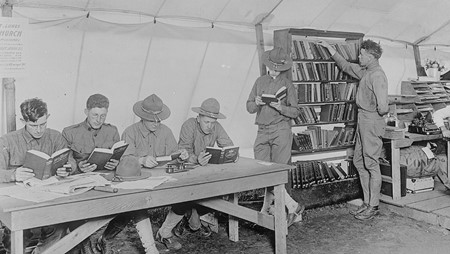
Camping
Ninety years ago, we made the very first standard-issue backpack for the Boy Scouts, the Yucca Pack. Ever since then, Diamond Brand Gear’s partnership with Scouts has been one of the most enduring and impactful parts of our legacy as a company.
It was crafting durable, top-quality goods for Scout camps and councils — from bags and gear to our flagship canvas wall tents and packable Scouting tents — that first marked our entry to the world of gear craftsmanship.
It’s only fitting, then, that we honor this partnership as the title sponsor of this year’s Boy Scouts of America National Outdoor Conference.
Why we’re proud to be 2021 BSA National Outdoor Conference sponsors
As the largest biennial gathering for Boy Scouts of America employees and volunteers, we’re thrilled to collaborate on such a key cornerstone of leadership in Scouting today. (And we were happy to donate commemorative messenger bags made from reclaimed tent materials, too!) Our support for the Scouting community goes far beyond a weekend’s event, though.
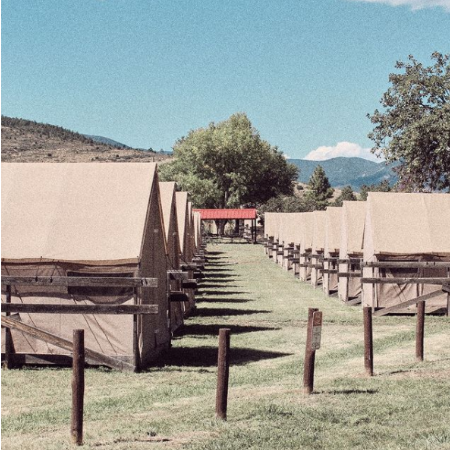
Tested by us, trusted by Scouts
From Camp Daniel Boone in North Carolina to the 137,000-acre Philmont Scout Ranch in New Mexico, our tents, made by hand in the Blue Ridge foothills, are favored by Scout camps across the country for a reason. We craft them to last, using only the most durable of fabrics, sealed seams, triple reinforced corners and sturdy grommets. Tested in the harshest of conditions, and with an in-house repair shop to boot, our tents are designed to keep powering scouts’ adventures for generations.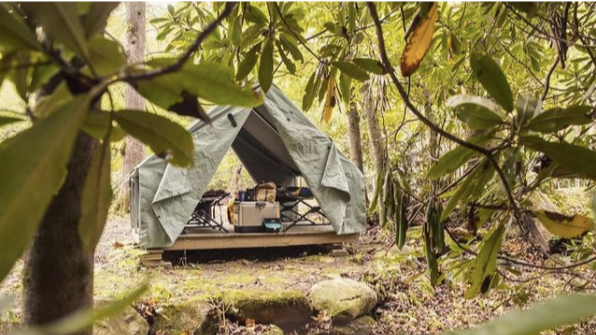
Have any upcoming Scouting adventures of your own? Feel free to check out more of our time-tested, handcrafted gear for Scouts by tapping the button below. Your partners in adventure,The Diamond Brand Gear team
This article is sponsored by Diamond Brand as part of their great donation to the 2022 National Outdoor Conference.
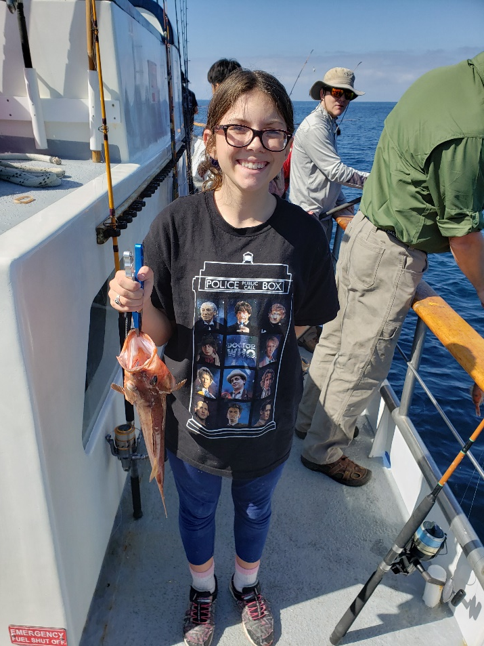
Fishing
Where is the best place to spend your program dollars? For Scouting Executives and Volunteers, this must be the million-dollar question.
What is the purpose of spending these precious dollars? The Wildlife Conservation Profession has a initiative called R3. The three R’s stand for Recruitment, Retention and Re engagement. If you don’t know this, virtually all wildlife conservation dollars are raised by the sales a licenses and related equipment. All guns, ammunition and fishing related gear has a tax on it for funding conservation. The State Agencies whose job is conservation know this and have initiatives to recruit sportsmen and women to fish and hunt.
We in Scouting should see R3 in our ranks also. We should be thinking R3 for both Youth and Adult Volunteers.
Boy’s life magazine did a survey. They asked Cub Scouts and Boy Scouts what activities they expected to do after 3 months after their registration. Their answer at the top was Camping and hiking. The Cub Scouts had fishing as #5 and the Boy Scouts had fishing as #3. Surprisingly, these were both above shooting.
So, to have satisfied customers, you need to meet their expectations. Do we inherently make a promise to the youth by their expectations and don’t meet them? How about looking at fishing as your hook? (Pardon the pun, I just couldn’t help myself)
Here is one way to start. Consider having a Certified Angling Instructor Class (CAI) in your council. This class will give you more knowledgeable and enthusiastic Volunteers. Your Fishing, Fly Fishing and Wildlife Conservation Merit Badge Counselors are your target market for this class.
From the CAI class, see if you can start a Council Fishing Committee. You will need a leader who has the management skills to run a committee. This Committee runs fishing events in your council.
It is really that easy.
If you want more Youth, look at fishing. It is the best bargain in Scouting!
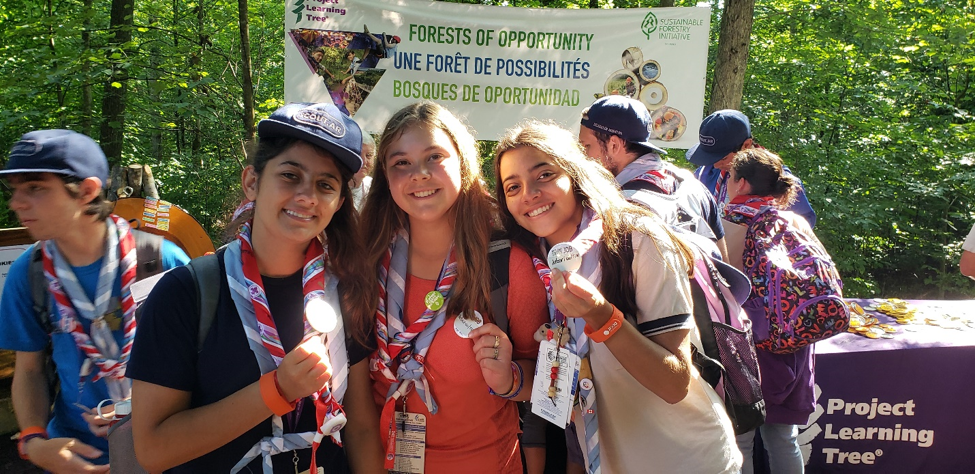
Outdoor Ethics/Leave No Trace
CONSERVATION THROUGH FOREST MANAGEMENT CERTIFICATION. Sustainability is a consideration for today’s council properties. Scouting principles promote responsible use of natural and human resources such as forests, water, land, outdoor ethics, and good stewardship of BSA lands for today and tomorrow. Continuous improvement and measured results are part of a sustainability program. Certification to Sustainable Forestry Initiative® (SFI) Forest Management Standard provides a proof point for responsible – and measurable – management of forest resources.
SFI® is an independent, non-profit organization with a mission to advance sustainability through forest-focused collaborations. Currently over 100,000 acres of both Philmont and the Summit Bechtel Reserve are SFI certified. This means that these properties have conservation plans that are in compliance with the SFI Forest Management Standard that promotes healthy forests.
The SFI Forest Partners Program, which is a partnership between SFI, Meredith, National Geographic, Pearson, Macmillan, Hearst Enterprises and Boy Scouts of America have provided assistance for initial certification, including funding for assessments of potential participants’ plans, consulting fees, and initial audit readiness.
To learn more about the Sustainable Forestry Initiative, visit www.sfiprogram.org. To learn more about how SFI is collaborating with BSA, see www.sfiprogram.org/scouts/.
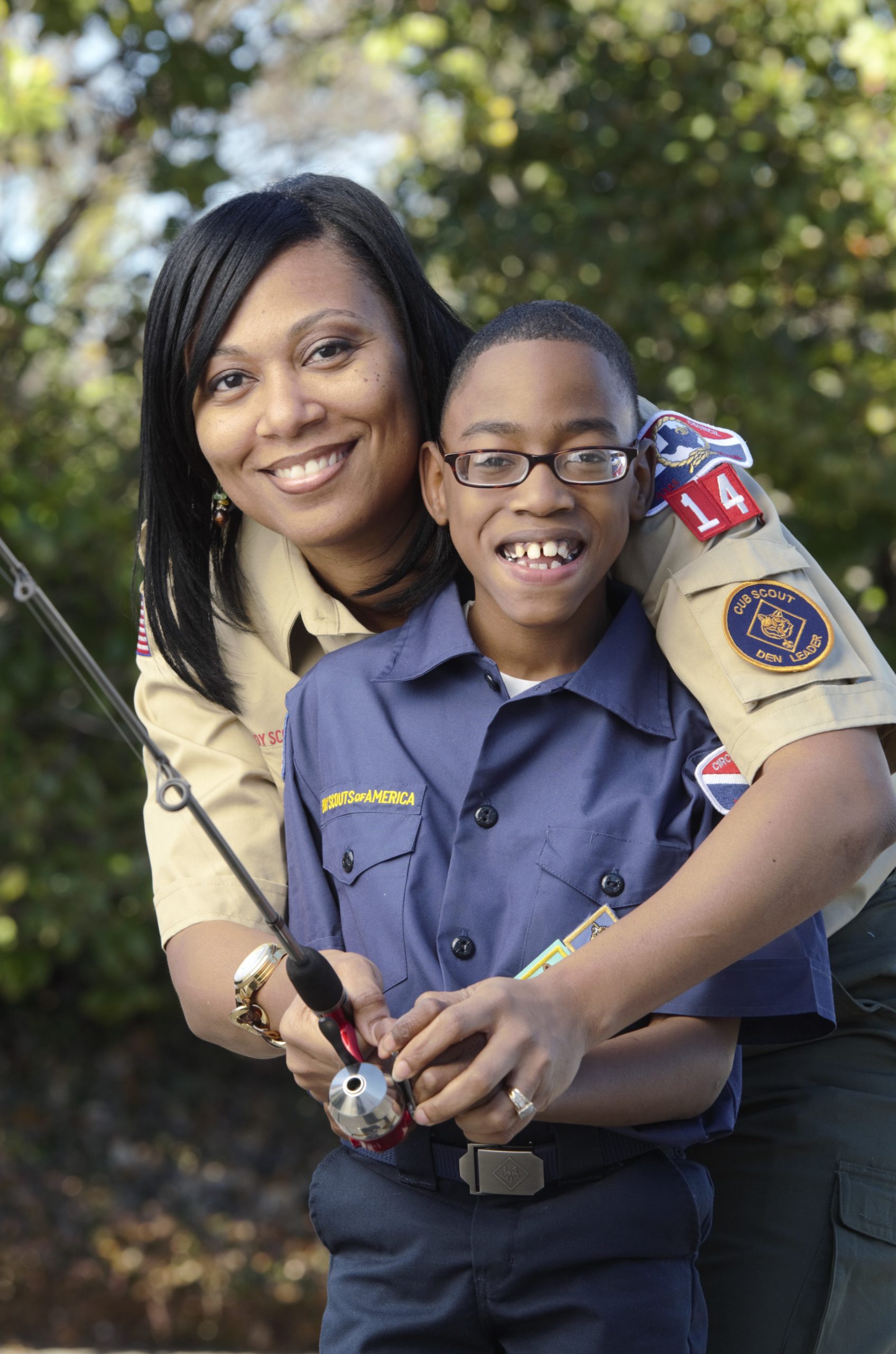
Fishing
What makes fishing such a great outdoor activity? Especially today, we are not fishing to feed our families. We fish for the challenge of fooling the fish into thinking we can imitate the natural environment and their prey. Many times, we catch and release the fish. We do this so we can keep a resource and possibly catch them when they have grown bigger.
Most times we go fishing not to catch fish but, to be outside many times sitting next to a beautiful mountain stream or rocking with the blue ocean. It is an activity that will transport us away from the stresses of everyday life and the only thing we can think about is concentrating on what we must do next to catch that fish.
The act of fishing drives us to want to preserve this experience for ourselves. In the long run, it makes us want to preserve it for future generations. From this, we learn about wildlife conservation. Fishing teaches us to care about things beyond ourselves.
The fact is that I would probably not be a Scout Leader without fishing.
My father was raised in a very poor part of Los Angeles from a poor Japanese immigrant family. The local Catholic Church had the best school in the area. My Grandparents valued education as the way out of poverty so my dad and his brother we enrolled in that school.
That school had a Boy Scout Troop. My father told me that his lifetime love of fishing came from learning to fish in Boy Scouts. He passed his love for fishing to me and enrolled me in Scouts as soon as I was old enough. I did the same thing when my son was old enough to be a Tiger Scout. My dad only became a Second Class Scout but he always lived by the Scout Oath and Law.
We, as Scout Leaders, have many opportunities to influence many generations ahead of us. It is why most of us are Scout Leaders. It would have to be obvious to you why, I have chosen fishing as my way of keeping Youth active in our movement. We all must have that special bait to keep and retain Youth. Therefore, fishing is my tool.
Email blast!
Email blast!




